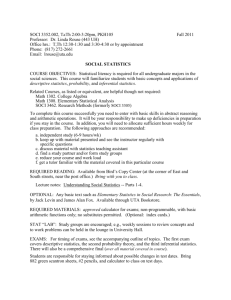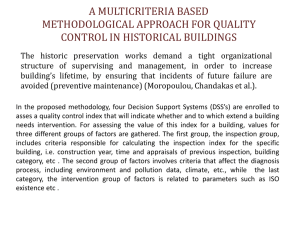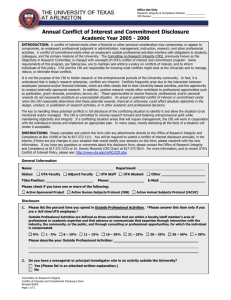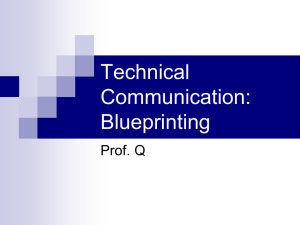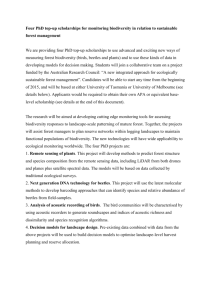UTA Program Description - PhysTEC @ Cornell
advertisement
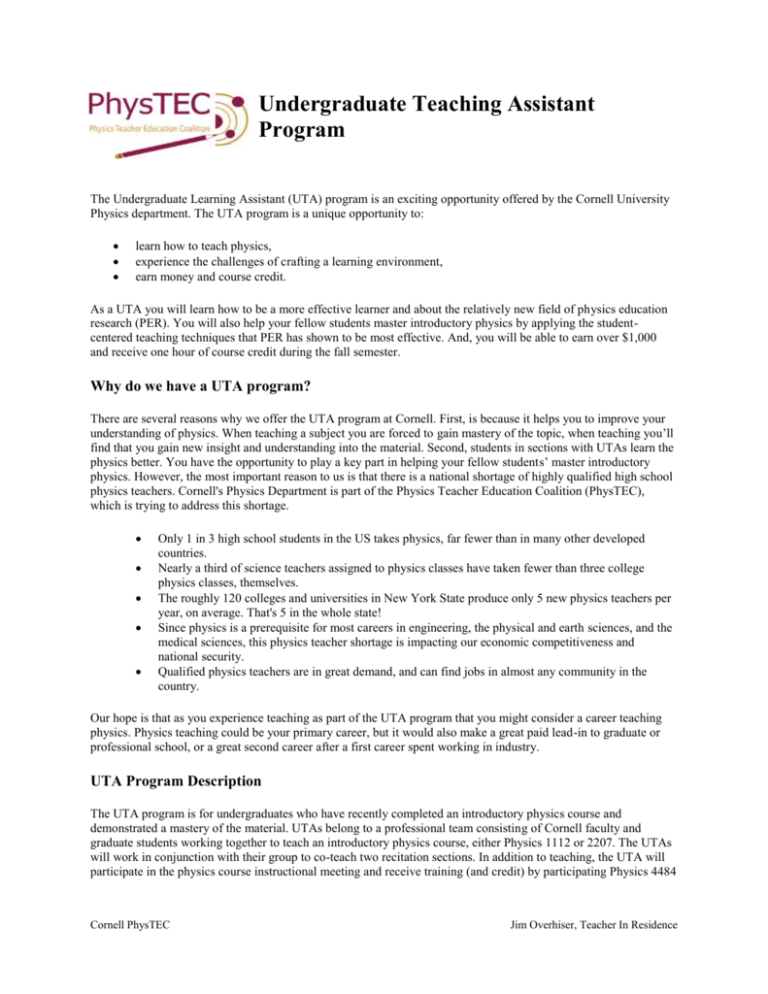
Undergraduate Teaching Assistant Program The Undergraduate Learning Assistant (UTA) program is an exciting opportunity offered by the Cornell University Physics department. The UTA program is a unique opportunity to: learn how to teach physics, experience the challenges of crafting a learning environment, earn money and course credit. As a UTA you will learn how to be a more effective learner and about the relatively new field of physics education research (PER). You will also help your fellow students master introductory physics by applying the studentcentered teaching techniques that PER has shown to be most effective. And, you will be able to earn over $1,000 and receive one hour of course credit during the fall semester. Why do we have a UTA program? There are several reasons why we offer the UTA program at Cornell. First, is because it helps you to improve your understanding of physics. When teaching a subject you are forced to gain mastery of the topic, when teaching you’ll find that you gain new insight and understanding into the material. Second, students in sections with UTAs learn the physics better. You have the opportunity to play a key part in helping your fellow students’ master introductory physics. However, the most important reason to us is that there is a national shortage of highly qualified high school physics teachers. Cornell's Physics Department is part of the Physics Teacher Education Coalition (PhysTEC), which is trying to address this shortage. Only 1 in 3 high school students in the US takes physics, far fewer than in many other developed countries. Nearly a third of science teachers assigned to physics classes have taken fewer than three college physics classes, themselves. The roughly 120 colleges and universities in New York State produce only 5 new physics teachers per year, on average. That's 5 in the whole state! Since physics is a prerequisite for most careers in engineering, the physical and earth sciences, and the medical sciences, this physics teacher shortage is impacting our economic competitiveness and national security. Qualified physics teachers are in great demand, and can find jobs in almost any community in the country. Our hope is that as you experience teaching as part of the UTA program that you might consider a career teaching physics. Physics teaching could be your primary career, but it would also make a great paid lead-in to graduate or professional school, or a great second career after a first career spent working in industry. UTA Program Description The UTA program is for undergraduates who have recently completed an introductory physics course and demonstrated a mastery of the material. UTAs belong to a professional team consisting of Cornell faculty and graduate students working together to teach an introductory physics course, either Physics 1112 or 2207. The UTAs will work in conjunction with their group to co-teach two recitation sections. In addition to teaching, the UTA will participate in the physics course instructional meeting and receive training (and credit) by participating Physics 4484 Cornell PhysTEC Jim Overhiser, Teacher In Residence ‘Teaching and Learning Physics’. This is a fantastic opportunity that will equip you to be more effective as a communicator and team-leader, and help to more thoroughly develop your own understanding of physics. What is involved in the UTA program? The Undergraduate Teaching Assistant (UTA) Program involves three related paid activities each week, requiring a total time commitment of roughly 8 hours. It involves participating in the physics course’s instructional meeting, coteaching two recitation sections, and attending a course on teaching physics. In addition to these set events there will be some need to additional outside preparation. Preparation: The course instructional team - Physics faculty, graduate TAs and UTAs - will meet weekly for 1½ hours to prepare for the upcoming cooperative learning session and reflect on the previous week’s activities. Studies at other universities indicate that UTAs are particularly sensitive to the struggles of their peers in learning science and can bring new insights to the faculty and graduate TAs. Imagine collaborating with a group like this where your contributions will be so highly valued! Practice: Each UTA will partner with a graduate TA to facilitate two one-hour recitation sections each week. Section students are guided to work in teams, solve problems and present them to the others. The UTA and TA will ask questions to guide the students toward a fuller understanding of the subject matter, and provide feedback to the lead instructor. Physics Education Research (PER) has shown that this cooperative approach improves learning outcomes for students. Pedagogy: UTAs earn 1 credit for their participation in the 1½ hour weekly seminar course, Physics 4484/7684 ‘Teaching and Learning Physics’. This interactive seminar introduces you to key teaching and learning concepts and guides you to reflect upon your own experiences. You will receive a practical introduction to important concepts in physics teaching and apply those concepts to engage introductory physics students in collaborative problem solving. UTAs report that they become better learners and significantly improve their understanding of the physics. Important Details: UTAs will receive a stipend of $9.00/hour for approximately 8 hours per week, which covers the full time commitment required for the activities listed above. You will also receive 1 hour of credit for the Teaching and Learning Physics seminar, to provide documentation of your teaching experience on your transcript. For further information, access the following web site: www.phystec.org/ http://phystec.physics.cornell.edu/ Cornell PhysTEC Jim Overhiser, Teacher In Residence
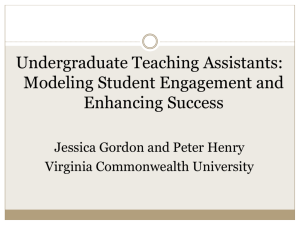

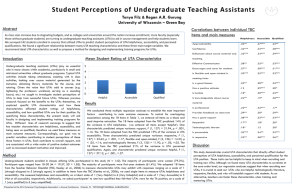

![presentation [MS PowerPoint 189KB]](http://s2.studylib.net/store/data/005263596_1-69d08c3f7e80bd1aee48ef31e66ebbc5-300x300.png)
